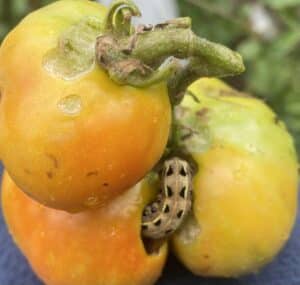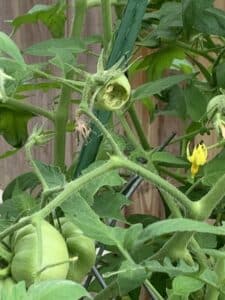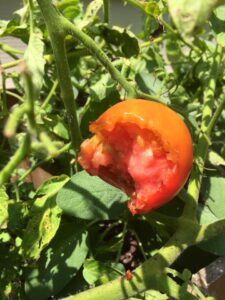Juicy tomatoes are elite veggies for summer, but backyard critters can keep eating your tomatoes, leaving a grimy scene!
Here, you will learn the tricks to keep the pesky intruders from your tomato harvest. Stay tuned!
Table of Contents Show
What is Eating My Tomatoes At Night or Day?
Tomatoes are ready for picking from June to November (early summer to late fall).
But, many pests and vermins also wake hungry from hibernation in summer to feast on tomatoes.

Most pests are small, sneaky, and munch quietly, while some large critters may visit during the day or take advantage of the night.
So, it’s important to identify these creatures and the signs left by them to keep your tomato harvest safe.
1. Common Pests
Pests like worms, snails, bugs, and beetles are the most likely intruders on your tomato plants.
Worms and Insects
Worms like caterpillars, tomato fruit worms, squash bugs, and hornworms are the culprits behind the holes in tomatoes.
These voracious worms tunnel into the tomato berries actively throughout the day and night, chewing the leaves and stem along with the fruits.
Hence, the infested fruits ripen earlier than normal.
Tomatoes start to rot from the core after infestation, and you might find bite marks or holes with irregular edges in the leaves and stalks.

Worms attack the tomato plants to complete their lifecycle and hide under the leaves and inside the fruits.
Similarly, open wounds left by worms can be a point of fungal infections, later spreading to the whole vegetable patch.
Snail and Slugs
Snails and slugs are mostly active in moist sunny weather and are noticeable for the sticky and shiny trail they leave behind.
Their damage is pronounced in the plant parts that lie closer to the moist soil surface.
In the daytime, they hide in the mulch, behind the pots, and often in warm, moist, shady places.
Also, they form larger holes in the tomatoes, leave large bite marks with irregular edges on the stems and leaves, and cut the flower and roots.
2. Pecking Birds
Birds usually target the ripe tomato fruits present in the high vines.

They peck their beaks in the tomatoes to reach the seeds and juicy center. So, you may notice holes in tomato fruits that lie just above the ground.
Normally, birds visit tomato gardens during the day and are rarely nocturnal.
Although they mostly eat fruits, birds also pluck or eat the leaves and other parts from tomato seedlings to build their nests.
3. Herbivores & Omnivores
Animals like raccoons, rabbits, voles, and deer are nocturnal feeders.

Squirrels, chipmunks, skunks, and groundhogs are day intruders who take bites out of ripe fruits and munch the roots.
Most animals leave footprints or droppings on the ground around the plants or vegetable patches, making it easy to identify the culprit.
Can You Eat Tomatoes with Holes In Them?
Your tomatoes remain safe from the tomato fruit worms, snails, and slugs until they bear fruits.
If you want to save your Broccoli leaves, learn what can eat them?.
How to Treat the Attack of Tomato Eaters?
You can prevent further crop damage if you are late to safeguard tomatoes.
- Spray weak blasts of dilute salt water to remove the pests and their eggs.
- Trim the bitten parts and toss away the infected or rotten fruits.
- Place sticky traps around the seedlings to trap hovering pests.
- Spray neem oil at the site of infection to kill sap-sucking pests like stinkbugs.
- Install backyard lights at night to scare off herbivores.
- Use organic spinosad every other week during infestation to keep the chewing insects at bay.
How to Protect Your Tomatoes from Being Eaten?
There are several ways to prevent these intruders from eating the tomatoes and destroying the plants by making preparations during mid or late winter.
| Intruders | Ways to Prevent |
|---|---|
Worms & Insects | Apply B.T. insecticides on the plant parts Attract predatory wasps by planting sunflower, fennel, parsley with tomatoes Grow companion plants like basil, dill, and marigolds around the tomatoes to deter pests Use covers to safeguard the fruits |
Snails & Slugs | Spray organic slug pellets around the plants Water in the morning to keep the soil dry at night Scatter crushed egg-shells in the soil Place copper barriers around the tomato plants |
Birds | Place bird feeders or baths around the garden patch Keep scarecrows at the planting site Cover the fruits with thin cloth to protect them |
Mammals | Setup scaring tactics like scarecrows around the tomatoes Place traps or cages to catch small mammals Spray urine of the potential predators around the plants Cover or grow the plants in steel nettings |
From Editorial Team
Conclusion!
Identify intruders and use immediate methods to drive the raiders and keep them from eating your tomatoes.
Also, use eco-friendly solutions that don’t harm other beneficial pollinators and animals.
